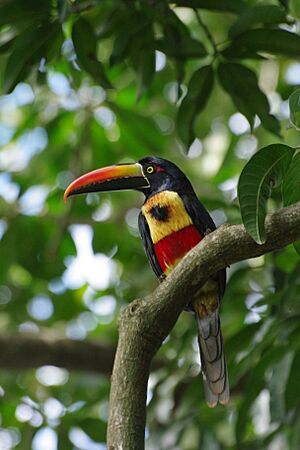Fiery-billed aracari facts for kids
Quick facts for kids Fiery-billed aracari |
|
|---|---|
 |
|
| In Alajuela, Costa Rica | |
| Conservation status | |
| Scientific classification | |
| Genus: |
Pteroglossus
|
| Species: |
frantzii
|
 |
|
| Synonyms | |
|
|
The fiery-billed aracari (Pteroglossus frantzii) is a colorful bird that belongs to the toucan family. You can find it living in the forests of Costa Rica and Panama. It is known for its bright colors and a large, striking bill.
Contents
About This Bird
Scientists who study animals often group them based on how they are related. The fiery-billed aracari is very similar to another bird called the collared aracari. Some people even thought it might be a type of collared aracari a long time ago.
This bird's scientific name, frantzii, honors a German scientist named Alexander von Frantzius. He was a naturalist who studied nature.
What Does It Look Like?
The fiery-billed aracari is about 45 centimeters (18 inches) long. It weighs between 225 and 280 grams (8 to 10 ounces). Like other toucans, it has very bright colors and a big bill.
Its bill is special. It has a thin, light line at the bottom. The lower part of the bill is black. The top part is mostly red, with a black top edge and a yellow tip. The base of the bill is greenish.
Adult aracaris have a black head, neck, and throat. They have a reddish-brown band around the back of their neck. Red skin can be seen around their eyes. Their back is blue-green, and their rump (the area above the tail) is red. Their belly is bright yellow with a red band across it. There is also a black spot in the middle of their chest. Their upper legs are reddish-brown.
Female aracaris look much like males. However, their reddish-brown neck band is a bit darker. Their bill is also a little shorter. Young aracaris are not as brightly colored. Their patterns and bill colors are not as clear as the adults'.
Where Do They Live?
The fiery-billed aracari lives along the Pacific coast of Costa Rica. Its home range goes south into western Panama. It used to live a bit further east in Panama.
These birds like to live inside and at the edges of wet forests. They can be found in both old, untouched forests and newer forests. They usually live from sea level up to about 1,200 meters (3,900 feet) high. Sometimes, they can be seen as high as 1,800 meters (5,900 feet).
Behavior
Movement
The fiery-billed aracari stays in its home area all year long. It does not migrate to other places.
Social Life
Fiery-billed aracaris often travel in groups. These groups usually have about six or more birds. Sometimes, other types of toucans join their groups. They also sleep together in tree holes. Several birds might share one hole overnight.
What Do They Eat?
The fiery-billed aracari mostly eats fruit. But they also eat large insects. Sometimes, they will eat the eggs and baby birds from other birds' nests. They also eat other small animals.
They usually look for food high up in the trees, near the top branches. They can also find fruit lower down. They get fruit by reaching from a branch. They might bend over or even hang upside down to grab it.
Reproduction
In Costa Rica, fiery-billed aracaris usually have their babies from January to April. This time might be longer in Panama. They typically lay two eggs, but sometimes more.
They usually make their nests in holes made by woodpeckers. They might use an old, empty hole. Or, they might even kick out the woodpeckers to use their hole! These nests can be as high as 30 meters (98 feet) off the ground.
We don't know exactly how long the eggs take to hatch. We also don't know how long it takes for the young birds to be ready to fly. Both parent birds take turns sitting on the eggs. They also both bring food to the baby birds and young birds after they leave the nest. Sometimes, other adult aracaris help out. These helpers might be young birds from the parents' previous group of babies. Young baby birds are mostly fed insects.
Sounds They Make
The fiery-billed aracari makes high-pitched calls. These sounds are like "pseep" or "sis-sik" repeated in a series. These calls are very similar to those made by the collared aracari. They also make a croaking sound and a soft rattling noise.
Status
The IUCN (International Union for Conservation of Nature) checks on animals around the world. They have listed the fiery-billed aracari as a species of "Least Concern." This means they are not currently in danger of disappearing.
This bird lives in a large area. There are at least 50,000 adult birds, but their numbers might be slowly going down. No major threats have been found right now. These birds live in at least two protected areas in Costa Rica. However, since they are found in a smaller area in Panama now, more study might be needed.


